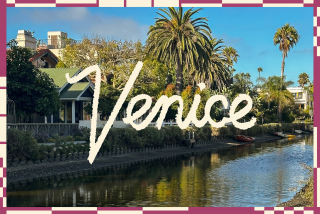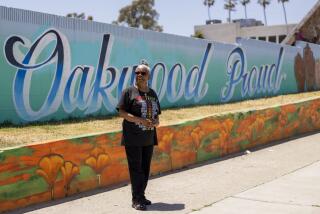Bohemian Rhapsody
- Share via
“Venice West” has lost another voice. The passing of Beat painter and poet Saul White in May left fewer witnesses to the undersung bohemia that flourished in Venice Beach during the 1950s and ‘60s. But those who remain are still dancing with the muse. As poet and painter Tony Scibella wrote in the late ‘90s, “Amazingly, 40 years later, those of us still alive, are still singing words in a flash/bang world, surviving drugs, alcohol, broken marriages, frantic affairs, meager bare-bones existence of bread sandwiches & empty hopes.”
While the Beat movement gained impetus in San Francisco and New York during the mid-’50s, a grungier revolution was afoot in Los Angeles. Venice was essentially a seaside slum, an artists’ colony surrounded by pimps, prostitutes, drug dealers and other outlaws. Visionary developer Abbot Kinney’s New World take on Venetian splendor seemed to have foundered, leaving a creative soup of poets and artists to simmer in marginal squalor. While Allen Ginsberg made headlines and novelist Jack Kerouac appalled the literary establishment, free spirits such as White, Scibella and Frank T. Rios were “blowing” improvisatory jazz-inspired poetry in the cafes and galleries of Venice. They may have had less formal education than some of their Northern California and Eastern counterparts, but spectators cheered, and cash came with the spontaneity.
Rios, 67, grew up in a New York City foster home and on the streets using drugs. On his first trip to Venice in 1954 he was more or less on the lam. “The cops were after me,” the poet recalls in his still-thick New York accent. “I was kind of a gangster. I was sticking people up.” He headed back to New York when the heat cooled, but returned to Venice in 1959 with renewed drive. “I gave my partner my piece, got on a plane and picked up a pen.”
The cramped Venice West Cafe on Dudley Avenue opened in 1958, offering Rios and others a stage. The cafe showcased poets and artists, with jazz performances a regular feature. Rios describes it as “naked.” A Beat artists’ row on Market Street that consisted of a gallery (the Gas House) and hotel (the Grand Hotel) enchanted Groucho Marx and Steve Allen. The scene got national exposure thanks to Lawrence Lipton’s lurid manifesto, “The Holy Barbarians.” After its publication in 1959, tourists descended on Venice. Scibella recalls, “You’d be sitting on the lawn, you know, smoking a cigarette, cooling it, and here’d come a family in shorts, camera and a straw hat to try and take your picture: ‘Look, there’s one!’ ”
As it happened, 1959 saw the zenith of the Venice Beat scene. The city knocked down the gallery in 1962 and later charged the Venice West Cafe’s owner with providing entertainment without a permit. An anti-bongo ordinance passed in 1965. Suicide, addiction and harassment from authorities beset an enclave that was waning by the mid-’60s. In 1960, Rios was incarcerated on a drug charge. In and out of jail for 11 years, he never stopped writing. “This is all I’ve ever done,” he says.
And for the remaining Venice Beats, that’s the whole point. Settled in Los Angeles, Rios makes art collages and continues to write; he’s working on his 10th self-published book and he is clean. Scibella, 70, lives in Los Angeles and co-owns Black Ace Books, a publishing concern and bookstore.
The words of Venice poets past and present are inscribed on the stone walls of a “Poet’s Walk” along a small stretch of the Venice boardwalk. As Scibella wrote a few years ago, “None of us would change anything in our life of verse, feeling duty too strongly, knowing we must pass it on to the new blood: that it can be done: poetry & magic & they must be true until it is their time to repeat after me.”
More to Read
Sign up for The Wild
We’ll help you find the best places to hike, bike and run, as well as the perfect silent spots for meditation and yoga.
You may occasionally receive promotional content from the Los Angeles Times.






